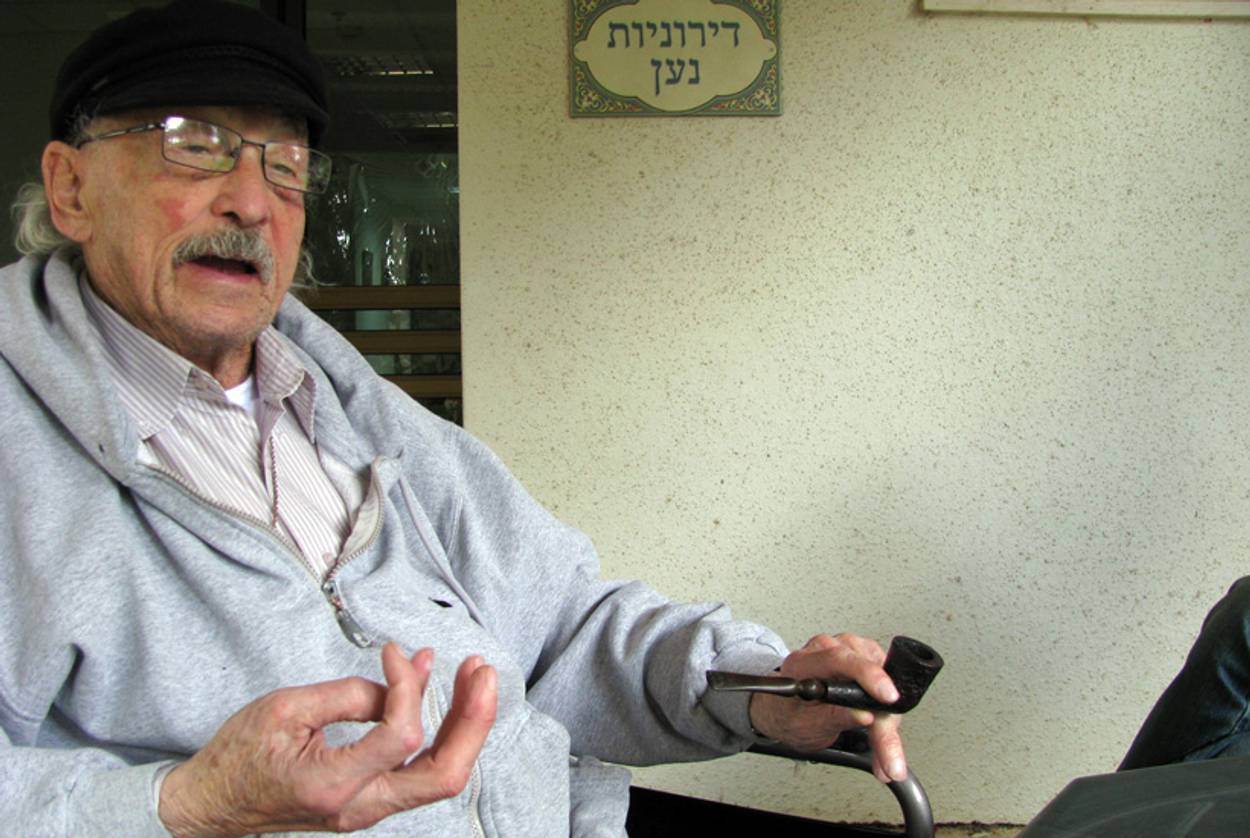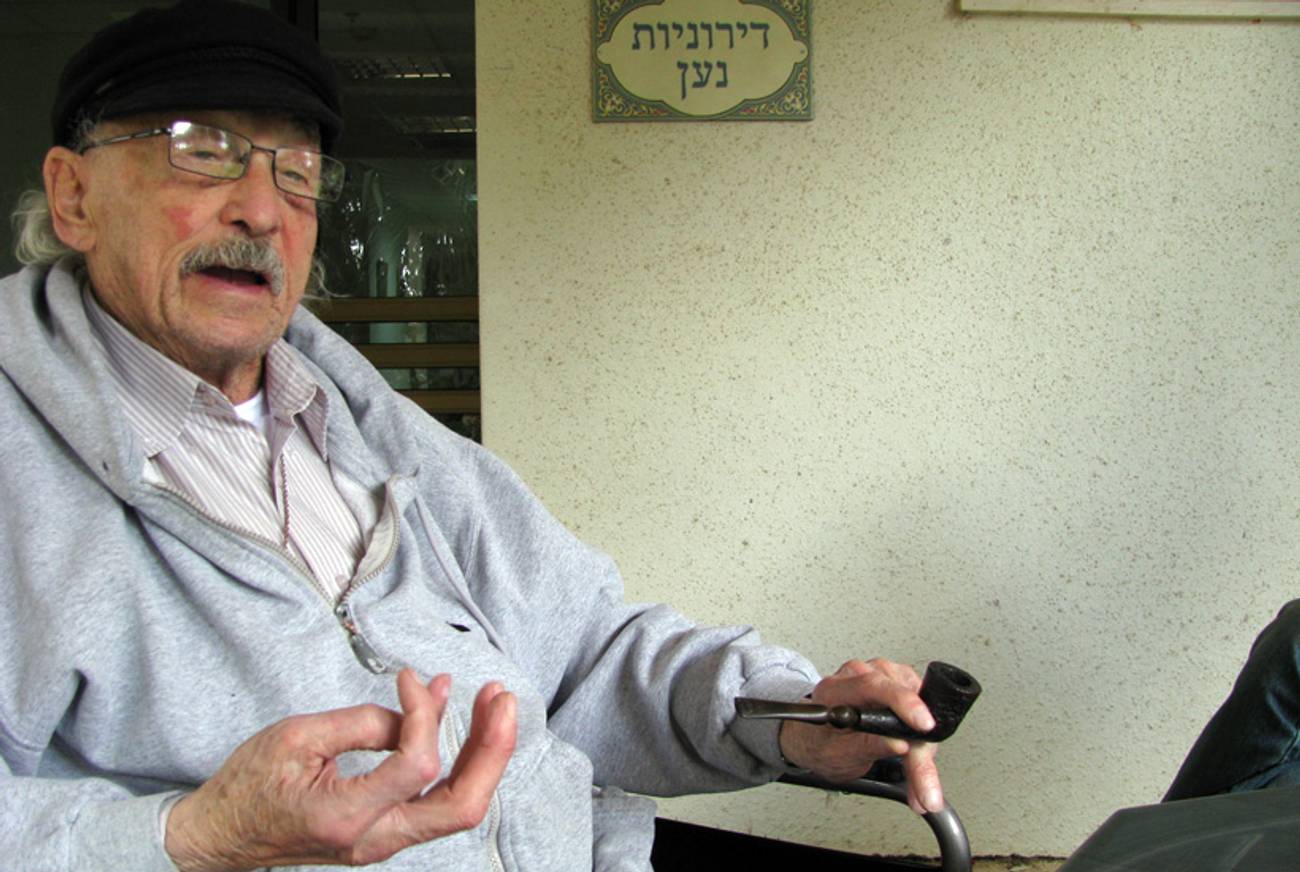A Flourishing $40 Million Medical Marijuana Industry Helps Israelis Forget
On a kibbutz south of Tel Aviv, medical marijuana helps soothe the pain of cancer patients and Holocaust survivors




On a recent afternoon in Kibbutz Naan, near the city of Rehovot, Israel, Moshe Rute took a hefty puff from his pot pipe, with the blessing of the government. His hands stopped convulsing, and he drifted into the story of how cannabis had done for him something that no person could—help him forget. A “Holocaust child,” he said the memories of his past—of hiding in a chicken barn in his native France to escape the Nazis, and the later death of his wife—haunted him.
For years Rute, 81, had been silenced by his psychological baggage and unsuccessful at sleep. But in 1988, when he arrived at the Hadarim nursing home in central Israel, where he was prescribed medical cannabis for a cocktail of ailments, he finally “opened up,” he said. “When I was a child my imagination saved me. I was alone, talking to the chickens. What saved me here was the cannabis.”
After the hourlong smoking session on the porch, we retreated into a spartan, ground-floor room, where the creative by-products of his drug use were on display. They included sketches of chickens and of his late wife, as well as black-and-white Pollock-style splatter paintings. He’d already completed three books.
In the United States, marijuana has been approved for medical use in 18 states and the District of Columbia and for recreational use in two states, but with federal statutes still criminalizing the drug, the future of the substance remains unclear. In Israel, meanwhile, the $40-million-per-year medical-marijuana industry has flourished.
Illegal for recreational use, today medical cannabis is prescribed to some 11,000 Israeli patients, up from 1,800 in 2009, according to the Israeli Health Ministry. It is used to treat an extensive list of illnesses including cancer, Parkinson’s, Tourette syndrome, and PTSD. While government attempts to limit use have sparked a heated debate, legislation is still relatively liberal. In May, Health Minister Yael German announced that an additional 11 doctors would be certified to prescribe cannabis—bumping up the number to 19—by the end of the year.
While rabbinic support for medical cannabis has long existed in Israel, government regulation is relatively new. The issue was raised for the first time in 2009, in the wake of a documentary titled Prescribed Grass, directed by Zach Klein. “I made the movie because my mother was suffering from cancer, and she was afraid to take hashish, afraid about the long-term effects,” Klein told me. “It was time that Israel woke up.”
He said the term marijuana has proven a detrimental moniker, conjuring up connotations of street crime, whereas the word cannabis has historical precedent in the Bible. He added that an accurate, shared vocabulary is needed for both politicians and patients to feel comfortable discussing the drug.
With chief nurse Inbal Sikorin, Klein built the Hadarim nursing home. Bustling trays of cannabis—in liquid, food, and pill form—for the lunchtime crowd, Klein and Sikorin agreed that the “munchies effect” is one of the drug’s most beneficial perks. Many patients here suffer from chronic pain from chemotherapy or other treatments and are at serious risk of having dangerously low body weight. Thus, Sikorin said, allowing the use of medical cannabis is an issue of medical ethics.
Sikorin remembered that in the days before marijuana was common treatment at Hadarim, “We had learned to prolong life, and we did that very well, but it wasn’t clear to me what we could offer them in terms of quality of life. We would always give them medicines that weren’t completely perfect. So, we would add other medicines, and they had their own side effects. This was, also, not at all cost-effective.” Of the 16 patients receiving medical cannabis, there are a few special cases, like half-paralyzed and wheelchair-ridden Rom (he requested his last name be omitted for privacy), 90 years old. He can’t speak or stay awake for more than a few seconds, let alone swallow a pill, and thus consumes the marijuana via vaporizer.
As Sikorin and I watched him inhale, we saw his eyes immediately light up. He yawned, to the delight of Sikorin. His wife Rachel prodded him to finish his third cannabis balloon, so that he could join her for lunch.
The pot doled out here comes from an organic greenhouse in the Galilee called Tikkun Olam, referring to the Jewish principle of healing the world. The largest of eight other government-sponsored cultivation digs, the cannabis farm supplies about 2,000 patients across Israel and goes by the motto derived from Psalm 118, “This is God’s doing; it’s marvelous in our eyes.”
At Tikkun Olam, crossbred products include a strain that reportedly inspires the most powerful high in the world and another that provides none at all. The latter is achieved by isolating the tetrahydrocannabinol, or THC, responsible for the “high,” and upping the concentration of the non-psychoactive cannabidiol, or CBD, which has anti-inflammatory and antioxidant properties. In the 1960s Israel was a world leader in research on marijuana and its components under the so-called grandfather of cannabis, professor Raphael Mechoulam, at Hebrew University, who first isolated the THC component.
Dr. Ruth Gallily, an immunology professor at Hebrew University who has researched CBD for 15 years, said the drug offers still unknown potential in treating neurological and physical illnesses. “Where the THC binds to the brain receptor, giving the high feeling, the CBD doesn’t bind, making it effective without toxicity,” she said. “It can be used for liver inflammation, rheumatoid arthritis, heart disease, and even diabetes type 1, which afflicts millions of people.” But the fact that it is a plant, she said, and is therefore harder to control and impossible to patent, makes it an unattractive investment for medical companies.
Dr. Reuven Or is the director of the bone-marrow transplant department at Hadassah Hospital in Jerusalem, where he said medical cannabis was first used. He said that holes in the bureaucratic system and demands on already overburdened doctors to handle prescription requests are compensated by “independent organizations and a lot of grace.” He maintains, though, that there’s still a long way to go in fully understanding the drug.
At the distribution center at Hadassah Hospital, patients, including young children, attend group classes on how to take the drug. Every patient has a prescription and pays a monthly fee of 370 shekels (about 100 dollars). To register at distribution centers like this, patients must present a green card signed by their doctor, specifying their monthly cannabis allowance. Patients can also petition to have the monthly cost covered by their health-care providers.
Daniel Davis, a 34-year-old yoga practitioner who has salivary gland cancer, attends those classes as both a student and a teacher. A self-declared “former pothead,” he said he has a “calling” to demystify the drug for nervous first-timers. On the other hand, he said, “The kind of sneaky part in me is telling me that I beat the system. Not only am I getting marijuana from the government, they’re also subsidizing three quarters of the cost.”
Davis said marijuana was “a savior” in helping him gain back the 20 pounds lost during intensive bouts of chemotherapy. He maintains a vegan diet and does yoga and meditation when he can muster the strength, though his deteriorating condition has his doctors pessimistic. But even in facing this difficult truth, Davis said, marijuana helped. “It enables me to let go,” he said, “to not fight so much, not to struggle with the current reality.”
***
Like this article? Sign up for our Daily Digest to get Tablet Magazine’s new content in your inbox each morning.
Shira Rubin is a journalist in Tel Aviv. Follow her on Twitter @shira_rubin.
Shira Rubin is a journalist in Tel Aviv. Follow her on Twitter @shira_rubin.